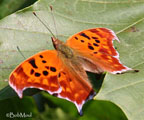Native Plants
Search for native plants by scientific name, common name or family. If you are not sure what you are looking for, try the Combination Search or our Recommended Species lists.
Ulmus alata
Ulmus alata Michx.
Winged Elm, Wahoo Elm, Cork Elm, Witch Elm
Ulmaceae (Elm Family)
Synonym(s):
USDA Symbol: ULAL
USDA Native Status: L48 (N)
Winged elm grows 30-40 ft. high with spreading branches that form a round-topped, oblong head. Opposite corky ridges occur on the branches in one plane. Dark-green leaves alternate, ovate, oblique, doubly serrate, acuminate, small. Leaves may turn dull yellow in fall. Fruit a samara, brown.
In the 18th and 19th centuries, the fibrous inner bark was made into rope for fastening covers of cotton bales. The common and Latin species names refer to the distinctive broad, corky wings present on some twigs; "Wahoo" was the Creek Indian name.
Plant Characteristics
Duration: PerennialHabit: Tree
Leaf Retention: Deciduous
Leaf Arrangement: Alternate
Leaf Complexity: Simple
Leaf Shape: Lanceolate , Oblanceolate
Leaf Venation: Pinnate
Leaf Margin: Double-serrate
Leaf Apex: Acute
Leaf Base: Cordate , Oblique
Fruit Type: Samara
Size Notes: To 24 m tall.
Leaf: Green
Bloom Information
Bloom Color: Yellow , GreenBloom Time: Feb , Mar , Apr
Distribution
USA: AL , AR , FL , GA , IL , IN , KS , KY , LA , MD , MO , MS , NC , OK , SC , TN , TX , VANative Distribution: S. VA to s. IL, c. MO & KS, s. to c. FL, OK & s.e TX
Native Habitat: Stream banks; woods; thickets
Growing Conditions
Water Use: MediumLight Requirement: Part Shade
Soil Moisture: Dry
CaCO3 Tolerance: Low
Cold Tolerant: yes
Soil Description: Variety of soils; best on terraces and bottomlands; may be somewhat weedy; fast growing; medium-lives.
Conditions Comments: Easily propagated from seed. Root Hormone is recomended for cuttings. Sometimes planted as a street tree in the southern states. Susceptible to Dutch elm disease. Often infected with powdery mildew.
Benefit
Use Ornamental: Fast growing, shade tree, attractive.Use Wildlife: Cover, Nesting site, Substrate-insectivorous birds, Seeds-granivorous birds, Seeds-Small mammals, Leaves-rabbit, Browse.
Use Medicinal: Indians seeped inner bark bark for diarrhea and to ease childbirth.
Use Other: Bark fibers woven into baskets and rope.
Interesting Foliage: yes
Attracts: Butterflies
Larval Host: Question Mark butterfly.
Butterflies and Moths of North America (BAMONA)
|
Question Mark (Polygonia interrogationis)  Larval Host |
Propagation
Propagation Material: Softwood CuttingsDescription: Elms germinated quickly from fresh, untreated seeds. Sow spring-ripening species immediately after collection; fall-ripening after winter storage and stratification. Easily transplanted.
Seed Collection: Collect seeds by raking from the ground soon after they fall or by stripping them from the branches. Air-dry a few days before storing. Store in sealed, refrigerated containers.
Seed Treatment: Fall-ripened seeds may be stratified for 30-60 days at 36-40 degrees.
Commercially Avail: yes
National Wetland Indicator Status
| Region: | AGCP | AK | AW | CB | EMP | GP | HI | MW | NCNE | WMVE |
| Status: | FACU | FACU | FACU | FACU |
From the National Organizations Directory
According to the species list provided by Affiliate Organizations, this plant is on display at the following locations:Lady Bird Johnson Wildflower Center - Austin, TX
Crosby Arboretum - Picayune, MS
Texas Master Naturalists - Lost Pines Chapter - Bastrop, TX
Bibliography
Bibref 298 - Field Guide to Texas Trees (1999) Simpson, B.J.Bibref 355 - Landscaping with Native Plants of Texas and the Southwest (1991) Miller, G. O.
Bibref 841 - Native Alternatives to Invasive Plants (2006) Burrell, C. C.
Bibref 291 - Texas Wildscapes: Gardening for Wildlife (1999) Damude, N. & K.C. Bender
Bibref 297 - Trees of Central Texas (1984) Vines, Robert A.
Search More Titles in Bibliography
Additional resources
USDA: Find Ulmus alata in USDA PlantsFNA: Find Ulmus alata in the Flora of North America (if available)
Google: Search Google for Ulmus alata
Metadata
Record Modified: 2015-10-13Research By: LAL